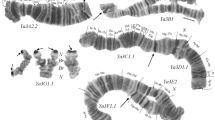Summary
Antisera against larval and adultXenopus hemoglobins as well as adult human hemoglobin showed no cross-reaction when tested by immunodiffusion against each heterologous antigen. In this test hemoglobin of a single animal produced two precipitation lines for larvae, but only one for adult stages. Immunoelectrophoresis also revealed more complex precipitation patterns for larval than for adult hemoglobins. Hemoglobin of the isogenic hybrid cloneXenopus laevis/X. gilli also reacted with antisera against normalXenopus hemoglobin.
Quantitation of hemoglobins, analyzed by radial immunodiffusion showed fewer than 1% of adult hemoglobin in red cells of larvae, but 30% at completion of metamorphosis. Two weeks later adult hemoglobin attained over 90%, and in red cells of adultXenopus an average of 1% larval hemoglobin were detected.
The relatively short transition period suggests that the loss of larval hemoglobin may be due to the elimination of larval red cells, and that the increase in adult hemoglobin may be indicative of a new cell line.
Similar content being viewed by others
References
Drabkin DL, Austin TH (1935) Spectrophotometric studies II. Preparations from washed blood cell: nitro oxide hemoglobin and sulfhemoglobin. J Biol Chem 112:51–65
Duncan DB (1955) Multiple range and multipleF-tests. Biometrics 11:1–42
Fey H, Pfister H, Messerli J, Sturzenegger N, Grolimund F (1976) Methods of isolation, purification and quantitation of bovine immunoglobulins. A technical review. Zentralbl Veterinaermed, Reihe B:23 269–300
Forman LJ, Just JJ (1976) The life span of red blood cells in the Amphibian larvae,Rana catesbeiana. Dev Biol 50:537–540
Forman LJ, Just JJ (1978) Cellular quantitation of hemoglobin transition during metamorphosis of the bullfrog,Rama catesbeiana. Am Zool 18:658
Huisman THJ, Meyering CA (1960) Studies on the heterogeneity of hemoglobin. I. The heterogeneity of different human hemoglobin types in carboxymethylcellulose and in Amberlite IRC-50 chromatography: Qualitative Aspects. Clin Chim Acta 5:103–123
Jurd RD, Maclean N (1969) The investigation ofXenopus laevis hemoglobins during development by a fluorescent antibody. Experientia 25:626–628
Jurd RD, Maclean N (1970) An immunofluorescent study of the haemoglobins in metamorphosingXenopus laevis. J Embryol Exp Morphol 23:299–309
Jurd RD, Maclean N (1974) Detection of haemoglobin in red cells ofXenopus laevis by immunofluorescent double labelling. J Microsc 100:213–217
Just JJ, Atkinson BG (1972) Hemoglobin transitions in the bullfrog,Rana catesbeiana, during spontaneous and induced metamorphosis. J Exp Zool 182:271–280
Just JJ, Schwager J, Weber R (1977) Hemoglobin transition in relation to metamorphosis in normal and isogenicXenopus. Wilhelm Roux' Arch Entwicklungsmech Org 113:307–323
Kistler A, Weber R (1975) A combined biochemical and morphometric study on tissue changes inXenopus larae during induced metamorphosis. Mol Cell Endocrinol 2:261–288
Kobel HR, Du Pasquier L (1975) Production of large clones of histocompatible fully identical clawed toadsXenopus. Immunogenetics 2:87–91
Kurata Y, Okada S (1968) Immunological investigations of embryonic haemoglobin ofBufo vulgaris. Blut 16:298–300
Maclean N, Jurd RD (1971) The haemoglobins of healthy and anaemicXenopus laevis. J Cell Sci 9:509–528
Maniatis GM, Ingram VM (1971) Erythropoiesis during Amphibian metamorphosis II. Immunochemical study of larval and adult hemoglobins ofRana catesbeiana. J Cell Biol 49:380–389
Moss B, Ingram VM (1968) Hemoglobin synthesis during amphibian metamorphosis. I. Chemical studies on the hemoglobins from larval and adult stages ofRana catesbeiana. J Mol Biol 32:481–492
Nieuwkoop PD, Faber J (1956) Normal Table ofXenopus laevis Daudin. North Holland, Amsterdam, pp 252
Ouchterlony OE (1958) Diffusion-in-gel methods for immunological analyses. Prog Allergy 5:1–78; 6:30–154
Perlman SM, Ford DJ, Rosbash MM (1977) Presence of tadpole and adult globin RNA sequences in oocytes ofXenopus laevis. Proc Natl Acad Sci USA 74:3835–3839
Reichlin M, Bucci E, Wyman J, Antonini E, Rossi-Fanelli A (1965) The role of α-and β-chains in the immunochemical difference between oxy and deoxy human haemoglobin. J Mol Biol 11:775–784
Stegeman H, Loeschke V (1962) Mikrobestimmung von Stickstoff als Indophenolblau nach Chloramin-T-Oxydation. Hoppe-Seyler's Z Physiol Chem 329:241–248
Sullivan B (1974) Amphibian hemoglobins In: Florkin M, Scheer BT (eds) Chemical zoology, Vol. 9. pp 77–122: Academic Press, New York
Wise RW (1970) An immunochemical comparison of tadpole and frog hemoglobins. Comp Biochem Physiol 32:89–95
Author information
Authors and Affiliations
Rights and permissions
About this article
Cite this article
Just, J.J., Schwager, J., Weber, R. et al. Immunological analysis of hemoglobin transition during metamorphosis of normal and isogenicXenopus . Wilhelm Roux' Archiv 188, 75–80 (1980). https://doi.org/10.1007/BF00848612
Received:
Accepted:
Issue Date:
DOI: https://doi.org/10.1007/BF00848612




